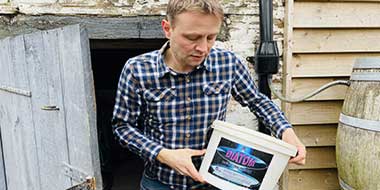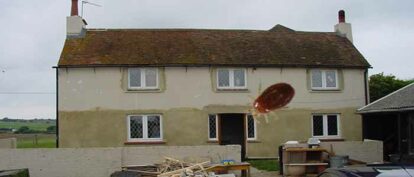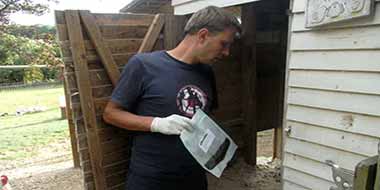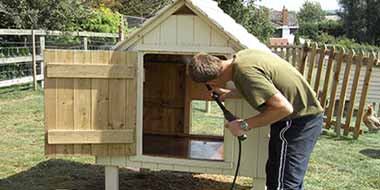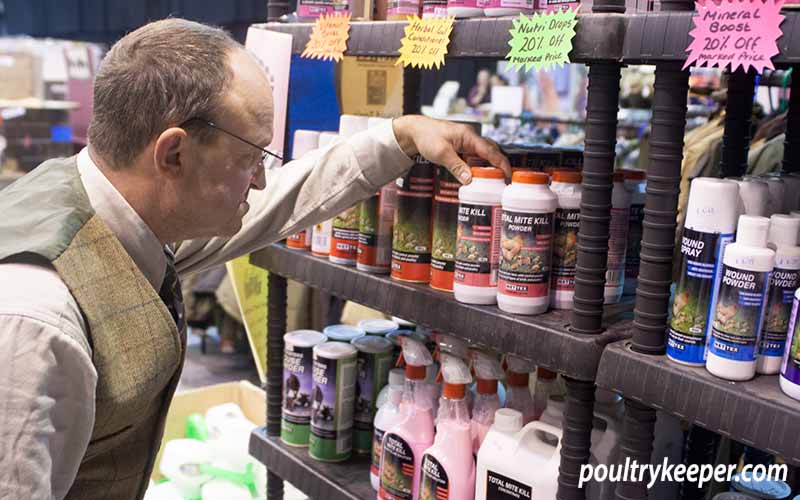
I have battled with red mite treatment on many occasions and have my views on the best red mite killer. This ‘Top 8 Red Mite Products’ article started as a blog post I wrote on safe red mite products, but after discussions with other fanciers on their favourite products, we added a few more, and from that list, this article was born!
Note:
If you found this page looking for information about red mite, then you're better off reading my Ultimate Guide to Red Mite first.
The last few years have seen an increasing number of ‘safe’ or ‘natural’ red mite treatments emerge on the market in a bid to fight against the poultry red mite, but what is the best red mite killer?
Commercially, there is more awareness of the use of chemicals in farming. Red mites have developed a resistance to a number of common chemicals that have been used in commercial premises and the UK Government has also recently banned some chemicals that were used to treat poultry houses with mites.
It is interesting to note that the old poultry books rarely mentioned red mite as they were not so much of a problem to poultry fanciers back then. Both commercial and domestic poultry houses used to be soaked annually in Creosote, and I believe this was having two actions. As well as preserving the wood, it was also stopping red mites from taking up residence in the coop, and it appeared to be killing off red mites that had already set up home.
Unfortunately, it appears that the modern Creosote substitutes don’t have the same effect, and they won’t deter mites from taking up residence once the coop is dry.
Be careful...
Whilst some products are safer to use than others and some suitable for organic use, you should still wear protective clothing such as a face/dust mask when dusting or spraying to stop inhalation and rubber gloves to protect hands from coming into contact with these products. Always follow the manufacturer's instructions.
Types of red mite control products
There are essentially two methods of attack: treatment on the bird and treatment of the poultry house. There are different products available to treat both your chickens and your chicken house and a few that we can use on both.
Red mite is what’s known as a temporary ectoparasite, spending only a couple of hours feeding on the bird, and can be found mainly in dark places in the coop, so most of your effort should be concentrated on the housing, especially in the cracks and crevices.
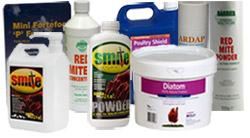
1. Products that can be used on your bird’s housing
- Liquids will penetrate into cracks, crevices and joints.
- Powders have a long-lasting effect and can be dusted around bedding and nesting material.
- Smoke will penetrate into the smallest of cracks.
2. Products that can be used on your chickens
- Can discourage mites from biting.
- Some products can kill mites if they bite.
- Products that kill mites often are not licensed for this use in birds producing eggs or meat for consumption.
Red mites are particularly resilient and can multiply quickly. They are capable of surviving several treatments of any product. To stop them multiplying dramatically after treating the chicken coop, it is best to re-treat again after 5 to 6 days when the eggs that managed to survive the first treatment have hatched before they are old enough to lay eggs again.
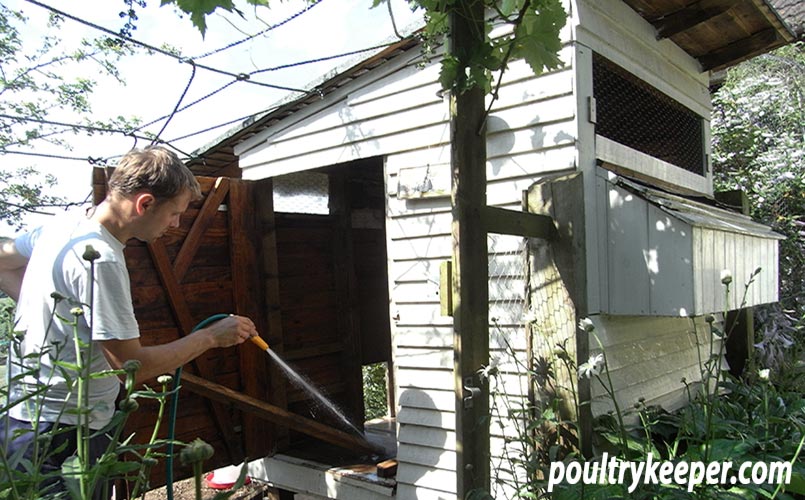
My top 8 red mite treatments
Here is a list of my favourite products for treating red mite. These are what I would consider the best red mite killers. Links are also included to suppliers of these products; if you’re familiar with poultry keeper, you’ll know it’s a hobby website and doesn’t sell anything, but affiliate links to other websites earn us small commissions, which help to keep the site running.
Poultry Shield
Treats: Housing
Probably THE most popular product amongst all poultry keepers that is used for weekly cleaning and red mite control. Poultry Shield is a liquid detergent that is very safe to use, containing no pesticides. It is diluted at 1:10 with water when used for general cleaning and washing the house or if you suspect a red mite infestation.
It works by washing the protective wax coating off the mite, and after 24 hours or so, they dry out and die. Being a liquid, it gets into cracks and crevices around the chicken house, where mites will be hiding during the daytime.
Diatom
Treats: Housing & Birds
Probably the next most popular product, if not joint ‘most popular’ with Poultry Shield. Diatom is usually used in conjunction with Poultry Shield. Once the house is dry, diatom can be spread around, concentrating on perch ends and nest boxes for ongoing protection. Diatom can also be used to dust your birds down and be added to dust baths to allow birds to rid themselves of lice.
It is basically Diatomaceous Earth, so it comes under several different names. Still, just like the Vacuum Cleaner and Hoover, the name Diatom or DE is often used rather than Diatomaceous Earth ( a bit of a mouthful). It is fossilised algae that have microscopically sharp edges that damage the outer waxy coating of the mite and absorbs the body fluid, so the mite dehydrates and dies. It is a very safe, natural product.
Red Mite Powder
Treats: Housing & Birds
Barrier Red Mite Powder can be used similarly to Diatom on the housing and the birds. Barrier Red Mite Powder can be used in Organic systems since it falls into the exempt category of products that use only plant oils as active ingredients. It contains tea tree, which acts as a natural repellent.
It comes in a handy shaker tub and is easy to apply to birds, and has a residual effect that lasts for several weeks after application. Red mite powder is always kept on my shelf for ‘midweek dusting’ when I spot some mites and haven’t got time to deep clean the coop.
Smite Powder
Treats: Housing & Birds
Smite Powder is another Diatomaceous Earth-based product (Diatomaceous Earth is naturally occurring fossilised algae). This has microscopically sharp edges that damage the outer waxy coating of the mite and absorbs fluids, so the mite eventually dehydrates and dies.
Smite powder should be used as Diatom above, concentrating on the ends of perches and nest boxes, so mites have to go through it to get to birds.
Smite Professional
Treats: Housing
Smite Professional comes with a handy pump that allows you to dispense the right amount into the water to get the correct dilution.
One pump = 30ml or 3% per litre of water. Use a 6% (two pumps) dilution per litre to treat. Use a garden sprayer to get into cracks and crevices for the best results. The thing I like about Smite is it’s easy to dilute and goes a long way.
Ardap
Treats: Housing
Ardap spray is an insecticide. It will kill pretty much any insect that will fly or crawl, including flies and other Diptera, beetles, cockroaches, moths, spiders, wood-lice, ants, mites and silverfish.
It kills on contact, so it is useful for concentrating on areas where you can visually see lots of red mites. When I’m short on time during the week, I keep a can handy to spray into the cracks if I see mite activity.
Mini ForteFog
Treats: Housing
Mini ForteFog ‘P’ Fumers are ‘smoke bombs’ to place inside the chicken coop. They contain 13.5% Permethrin, an insecticide that kills mites as well as other insects.
These are very easy to use, but remember to shut the birds out, close the coop’s door, and block off normal ventilation openings so the smoke filters out through the cracks where the red mites are hiding.
Red Mite-X
Treats: Housing
Barrier Red Mite X Concentrate cleans and disinfects poultry housing and is safe to use around feeding areas.
It has a sticky consistency that immobilises the mites, which then kills them. Red Mite-X concentrate is also suitable for Organic systems.
It is diluted with water at a rate of 1:20, so a 500ml bottle is enough to make up 10 litres of the solution, so I feel is a good value for money.
So there it is. Choose your weapon for the best red mite killer, and let battle commence!
Other useful articles & guides on red mite:
- The Ultimate Guide to Red Mite -A comprehensive guide to this ectoparasite.
- Will Red Mite Infest your House? - You might be surprised at the answer...
- How to Get Rid of A Serious Red Mite Infestation - One of my many battles to get rid of red mite on my chickens.









